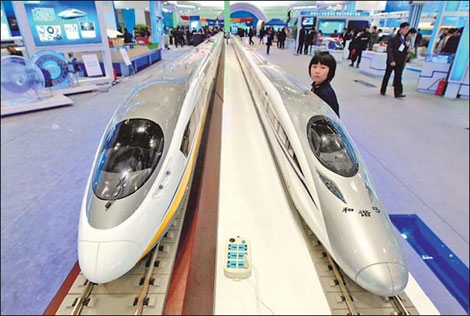High-speed rail stays on track
Updated: 2011-03-11 10:52
By Xin Dingding (China Daily European Weekly)
|
 Models of high-speed trains attract a child's attention at an exhibition in the China National Convention Center in Beijing on March 6. Grabbing media attention recently was the news that two senior Chinese railway officials were ousted. Gao Erqiang / China Daily
|
China's newly appointed railway minister has said the country will continue to develop its high-speed rail network as planned even after the former minister was ousted.
Sheng Guangzu, who took office on Feb 25 to replace Liu Zhijun, made the remarks on March 5 when responding to questions on whether China's policy of high-speed rail development will change with Liu's fall from grace.
Liu was placed under investigation for "severe violation of discipline" on Feb 12 by the discipline watchdog of the Communist Party of China (CPC).
Liu's is "an individual case" and will not have a big impact on the railway system's future development and morale, Sheng said.
He said the change of minister will not change the road map of China's high-speed railway development, as the country will continue to develop its fast train network under its national medium-to-long-term program.
The railway system runs stably and achieved its mission during the Spring Festival travel peak last month, he said.
It was the first time 62-year-old Sheng faced the media after taking office at the railway ministry. The former head of the General Administration of Customs was vice-railway minister before being transferred to customs as deputy commissioner in 2000.
Zhang Junbang, director of the Zhengzhou railway bureau and a deputy to the National People's Congress (NPC), said the plan for building high-speed railways in his bureau's territory this year has not changed, and a high-speed rail line linking Wuhan, capital of Central China's Hubei province, and Shijiazhuang, capital of North China's Hebei province, will be completed by the end of this year.
Following the removal of Liu and later the ministry's deputy chief engineer Zhang Shuguang - both leaders in China's high-speed railway development - the ministry faces doubts and pressure from many sides.
Some believe the ministry will not be able to pay back the huge loans it borrowed from banks for building the massive high-speed rail network, while others suspect the stunningly fast construction of the high-speed railways might generate potential safety hazards.
As to the solvency of the ministry's affiliated companies, Sheng said that the 1.8-trillion-yuan (196 billion euros) debt used for building the country's massive high-speed rail network was still "at a controllable level".
"I believe the high-speed rail market will be rosy" after many projects still under construction are put into service, Sheng said.
As for whether the ministry should build so many high-speed railways in only a few years, Wang Mengshu, a professor at the Research Center of Tunnel and Underground Engineering at Beijing Jiaotong University and a deputy to the NPC, said that forming a network in a relatively short period can generate more profits than laying out the railways one by one.
And the quick speed of construction is not likely to affect quality as the key to safety is the rail track, and China has overcome difficulties to make sure the tracks are safe for years so that trains will not derail at high speeds, he said.
Zheng Xinli, former deputy director of the policy research office of the CPC Central Committee and a member of the National Committee of the Chinese People's Political Consultative Conference, says that with the growth of the network and people's income, high-speed railways will gradually attract more passengers and eventually begin to make a profit.
By then, paying back the huge debt will not be a problem, Zheng said.
The country has planned to expand its high-speed rail network to 13,000 km by 2012 and to 16,000 km by 2020.
At the end of 2010, the network was already the world's longest at 8,358 km, of which 5,149 km were put into service in 2010.
E-paper

Sindberg leaves lasting legacy
China commemorates Danish hero's courage during Nanjing Massacres.
Preview of the coming issue
Crystal Clear
No more tears
Specials

NPC & CPPCC sessions
Lawmakers and political advisers gather in Beijing to discuss major issues.

Sentimental journey
Prince William and Kate Middleton returned to the place where they met and fell in love.

Rent your own island
Zhejiang Province charts plans to lease coastal islands for private investments
